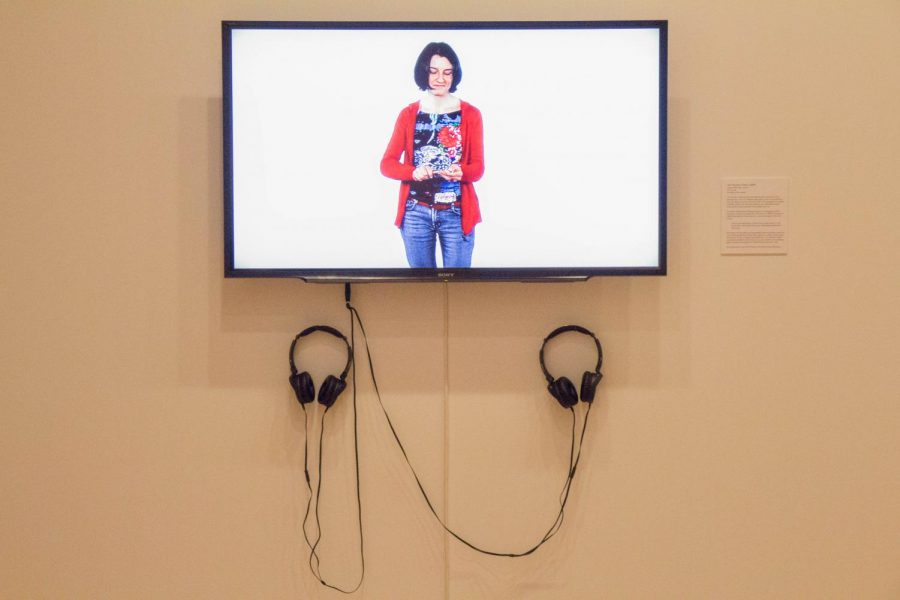Kennedy Browne exhibit critiques 21st century
Gareth Kennedy and Sarah Browne, two artists best-known throughout Europe, have conceptual art presented in an exhibit at Krannert Art Museum. The exhibit is on display until Feb. 9.
Oct 17, 2018
On top of the tallest building in Dublin, an actor sharpens a pencil to the nub. In a green room, another actor reads a script drawn from the Dell employee blog that details the firing of an entire division, while in the corner, young boys are celebrated for disabling their cribs and dropping out of school at an early age.
These are some of the quirky scenes from the Kennedy Browne Exhibition at the Krannert Art Museum. The pieces in this exhibit are created by Gareth Kennedy and Sarah Browne, two artists whose work is best-known throughout Europe. Their work presented here is conceptual art.
The exhibit will be on display from Oct. 4 to Feb. 9.
Deja Cook-Reynolds, sophomore in Engineering, entered the Kennedy Browne exhibit without any knowledge of the works that would be available to her.
“I literally just walked into that exhibit. I was like, ‘What is this?’” Cook-Reynolds said.
Get The Daily Illini in your inbox!
She saw Oculus Rift virtual reality headsets in the center of the room and was instructed on how to use them to enjoy the 360-degree video experience. The video detailed the dangers of social media and data collection by big technology corporations. She said she found the experience interesting and rewarding.
“I enjoyed the experience of being in a virtual work,” Cook-Reynolds said. “He was walking me somewhere, and I could not stop looking around. I was like, ‘Wow this is so amazing’… I thought that experience was very cool.”
The video is titled “Real World Harm (Act I)” and includes subtle references to Palmer Luckey, the inventor of Oculus. The 360-degree experience holds underlying hints toward his involvement in the 2016 Presidential election as a “troll” of the Clinton campaign, according to Amy Powell, the exhibition’s curator.
Powell gave more insight into some of the pieces presented. Through their work, the artists are trying to make critiques of multinational tech corporations and globalization, she said.
Throughout the exhibit, viewers will find familiar items, but those items will be placed in a different light.
“The artists are distilling materials from these scenarios of 21st-century capitalism and making work out of it,” Powell said.
Among those materials is a pencil. One of the artworks in the Kennedy Browne Collection features an actress sharpening a pencil from its original store-bought stage up until it’s nothing more than the eraser.
“The pencil is a good example because it comes from Milton Friedman, and all of our ideas culturally and politically about the free market … he made this speech in 1980 about the pencil being the perfect object of the free market,” Powell said.
Viewers can see a pencil and easily understand its working components and the value it presents to consumers. What they don’t think about is the amount of human interaction the finished product receives, Powell said.
“The rubber for the eraser comes from one place, the graphite comes from another place, the wood comes from another place and the workers never have to see each other … we can buy this pencil for super cheap and it’s that wonderful,” Powell said.
However, Powell said this idea is something the artists are critical of.
“It includes centuries of forced labor, and it actually isn’t this big happy system, so they start to interrogate that as an idea,” Powell said.
Jessica Hung, a junior in Business, is working as a marketing assistant for the museum. She said that while the pieces may be confusing, it’s gratifying once the true meaning is discovered.
What’s interesting about the museum, she said, is it provides students with the opportunity to see something they may not have been exposed to in the past.
“The museum really prides itself on taking exhibitions of a lot of different kinds of art,” Hung said. “For something like this, it’s something newer, and it’s not everyone’s taste, but when someone comes here, they can explore the different kinds of art.”






